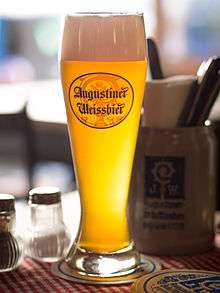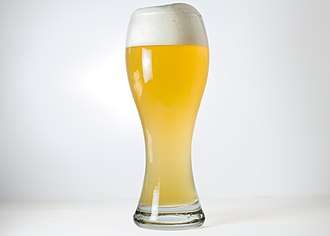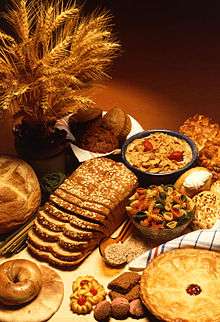Wheat beer
Wheat beer is a beer, usually top-fermented, which is brewed with a large proportion of wheat relative to the amount of malted barley. The two main varieties are Weißbier, based on the German tradition, and Witbier, based on the Belgian tradition; other types include Lambic (made with wild yeasts and bacteria), Berliner Weisse (a cloudy, sour beer), and Gose (a German-type sour, salty, herbal beer).

Varieties
Weißbier (German – "white beer") uses at least 50% wheat to barley malt to make a light coloured top-fermenting beer. Witbier (Dutch – "white beer") uses flavorings such as coriander and orange peel. Belgian white beers are often made with raw unmalted wheat.
German Weißbier and Belgian witbier are termed "white beers" because "wheat" has the same etymological root as "white" in most West Germanic languages (including English).[1]
Other wheat beer styles, such as Berliner Weiße, Gose, and Lambic, are made with a significant proportion of wheat.
Weizenbier

Weizenbier or Hefeweizen, in the southern parts of Bavaria usually called Weißbier (literally "white beer", but the name probably derives from Weizenbier, "wheat beer"), is a beer, traditionally from Bavaria, in which a significant proportion of malted barley is replaced with malted wheat. By German law, Weißbiers brewed in Germany must be fermented using a "top-fermenting" yeast, which is technically an "ale yeast".[2] Specialized strains of yeast are used which produce overtones of banana and clove as by-products of fermentation.[2] Weißbier is so called because it was, at the time of its inception, paler in color than Munich's traditional brown beer. It is well known throughout Germany, though better known as Weizen ("Wheat") outside Bavaria. The terms Hefeweizen ("yeast wheat") or Hefeweißbier refer to wheat beer in its traditional, unfiltered form. The term Kristallweizen (crystal wheat), or Kristallweißbier (crystal white beer), refers to a wheat beer that is filtered to remove the yeast and wheat proteins which contribute to its cloudy appearance.
The Hefeweizen style is particularly noted for its low hop bitterness (about 15 IBUs) and relatively high carbonation (approaching four volumes), considered important to balance the beer's relatively malty sweetness. Another balancing flavor note unique to Hefeweizen beer is its phenolic character; its signature phenol is 4-vinyl guaiacol,[3] a metabolite of ferulic acid, the result of fermentation by top-fermenting yeast appropriate for the style. Hefeweizen's phenolic character has been described as "clove" and "medicinal" ("Band-aid") but also smoky. Other more typical but less assertive flavour notes produced by Weißbier yeast include "banana" (amyl acetate), "bubble gum", and sometimes "vanilla" (vanillin).
Weißbier is available in a number of other forms, including Dunkelweizen (dark wheat) and Weizenstarkbier (strong wheat beer), commonly referred to as Weizenbock. The dark wheat varieties are made with darker, more highly kilned malts (both wheat and barley). The Weizenbocks typically have a much higher alcohol content than their lighter cousins.
The four largest brands in Germany are Erdinger, Paulaner, Franziskaner, and Maisel.[4] Other renowned brands are Augustiner, Weihenstephaner, Schneider (a bronze-coloured specialty), and Andechser. Regional brands in Bavaria are Hopf, Unertl, Ayinger, Schweiger and Plank. Aventinus is an example of Weizen Doppelbock, stronger and darker version of Weizenbock,[5][6] made by the G. Schneider & Sohn brewery in Kelheim.
British brewers producing cask-conditioned varieties include Oakleaf Eichenblatt Bitte, Hoskins White Dolphin, Fyfe Weiss Squad and Oakham White Dwarf.
Witbier
Witbier, white beer, bière blanche, or simply witte is a barley/wheat, top-fermented beer brewed mainly in Belgium and the Netherlands. It gets its name due to suspended yeast and wheat proteins which cause the beer to look hazy, or white, when cold. It is a descendant from medieval beers which were flavored and preserved with a blend of spices and other plants such as coriander, orange, and bitter orange referred to as "gruit" instead of using hops.
The style was revived by Pierre Celis at the Hoegaarden Brewery in Belgium[7] and the Celis Brewery in the United States[8] and is traditionally made with up to 50% raw wheat rather than wheat malt.[9] The beers have a somewhat sour taste due to the presence of lactic acid or acetic acid, much more pronounced in the past than today.[10] Also, the suspended yeast in the beer causes some continuing fermentation in the bottle.
Other varieties
A minor variety of wheat beer is represented by Berliner Weiße (Berlin White), which is low in alcohol (2.5% to 3% ABV) and intentionally tart. Sweetened syrups of lemon, raspberry or woodruff herb are often added before drinking.
Leipziger Gose is similar to Berliner Weiße but slightly stronger at around 4% ABV. Its ingredients include coriander and salt, which are unusual for German beers.
Belgian Lambic is also made with wheat and barley, but differs from nearly all beers in the use of wild yeast for spontaneous fermentation.
A variation on the barley wine style involves adding a large quantity of wheat to the mash bill, resulting in what is referred to as wheat wine. This style originated in the United States in the 1980s.[11]
Names and types
Wheat beers vary in name according to the place in which they are brewed and small variations in the recipe. Among those used are:
- Weißbier, short Weiße: "Weiß" is German for "white". These terms are used almost exclusively in the southern German state of Bavaria and in Austria.
- Weizenbier, short Weizen: "Weizen" is German for "wheat". These terms are used in the western (Baden-Württemberg) and northern German regions for Weißbier.
- Hefeweißbier or Hefeweizen: "Hefe" is the German word for yeast, added to indicate that the beer is bottle-conditioned (unfiltered) and thus might have sediment.
- Kristallweißbier or Kristallweizen: "Kristall" being German for crystal, added if Weißbier is filtered clear of sediment.
- Dunkles Weißbier or Dunkelweizen: a dark version of a wheat beer ("dunkel" is the German word for "dark").
- Weizenbock is a wheat beer made in the bock style originating in Germany.
- Witbier (Literally, "white beer") or simply Wit: Dutch language name for the Belgian style of wheat beer.
- Bière blanche (Literally, "white beer"): The French language name for wheat beer.
Serving
Bavarian-style wheat beer is usually served in 500 ml (17 US fl oz), vase-shaped glasses. In Belgium, witbier is usually served in a 250ml glass; each brewery (Hoegaarden, Dentergems, etc.) has its own shape of glass. Berliner Weiße is often served in a schooner.
Kristallweizen (especially in Austria) and American styles of wheat beer are sometimes served with a slice of lemon or orange in the glass. This is not traditional in Bavaria, and is generally frowned upon there.[2] The modern American custom appears to have originated in Portland, Oregon in the mid-1980s, where the Dublin Pub served Widmer Brothers Brewery's Weizenbier with a slice of lemon, to accentuate the citrus flavor of the Cascade hops.[12]
In northern Bavaria, it is common to add a grain of rice to kristallweizen, which causes a gentle bubbling effect and results in a longer-lasting foam.[13] A common item on pub menus in Bavaria is cola-weizen, which is a mix of cola and Weizenbier. Another mixture popular during the summer is a radler variant with a 50–50 mix of Weißbier with lemonade called "Russ", which is the German term for Russian.
When serving a bottled unfiltered wheat beer hold the glass on an angle and pour slowly. With about 10% or 15% left swirl smoothly to suspend the yeast, then add to improve the flavor, scent and appearance.
Sensory profile
Weißbiers feature fermentation by-products such as esters (which lend fruity flavors and aromas), especially isoamyl acetate, reminiscent of bananas, and the phenolic compound guaiacol, a metabolite of ferulic acid, which smells and tastes like cloves. Other phenolics sometimes found in Weißbiers evoke medicinal or smoky sensations. The bittering level of most Weißbiers is close to 15 International Bitterness Units, a very low level. Hop flavor and aroma are typically low.[2]
The ester and phenolic aspects are produced by the special type of yeast, rather than the high fraction of wheat in the grain bill.
The carbonation level can range from 5.5 grams per liter (approximately 2.7 volumes; slightly higher than that of most other German beers) to 7 grams per liter, or more. This produces a generous stand of foam, especially in light of the high protein content of wheat malt.[2]
References
- "Online Etymology Dictionary".
- Eric Warner, German Wheat Beer. Boulder, CO: Brewers Publications, 1992. ISBN 978-0-937381-34-2
- Donaghy, John A.; Paul F. Kelly; Alan McKay (15 October 1998). "Conversion of ferulic acid to 4-vinyl guaiacol by yeasts isolated from unpasteurized apple juice". Journal of the Science of Food and Agriculture. 79 (3): 453–456. doi:10.1002/(SICI)1097-0010(19990301)79:3<453::AID-JSFA284>3.0.CO;2-H.
- Liebrich, Silvia (17 May 2010). "Brauerei Maisel: Unser Bier". Süddeutsche Zeitung (in German). Munich, Germany. Retrieved 3 January 2017.
- "Weizendoppelbock". Archived from the original on 10 August 2016. Retrieved 29 August 2015.
- Weisses Bräuhaus G. Schneider & Sohn GmbH. "Schneider-Weisse".
- "Michael Jackson's Beer Hunter – Belgium's Great Beers". www.beerhunter.com. Retrieved 17 October 2009.
- Jackson, Michael (10 August 2000). Pocket Guide to Beer (Hardcover) (7 ed.). Running Press. p. 208. ISBN 978-0-7624-0885-6. ISBN 978-0-7624-0885-6.
- Eßlinger, Hans Michael (2009). Handbook of Brewing: Processes, Technology, Markets. Wiley. p. 101. ISBN 978-3-527-31674-8.
- "BT – Witbier: Belgian White". Morebeer.com. Archived from the original on 1 July 2013. Retrieved 14 August 2013.
- Bernstein, Joshua M. (17 October 2012). "Wheat of the Moment". Imbibe Magazine. Retrieved 12 January 2014.
- Adem Tepedelen (18 January 2009). "Hefeweizen Facts And Fiction". Imbibe.
- Weizenbier or wheat beer Archived 6 November 2007 at the Wayback Machine
Bibliography
- German Wheat Beer, Eric Warner, Brewers Publications (1992), ISBN 0-937381-34-9
External links
| Wikimedia Commons has media related to German Beers. |
